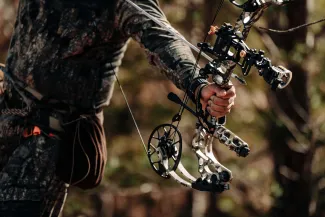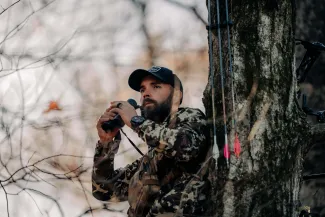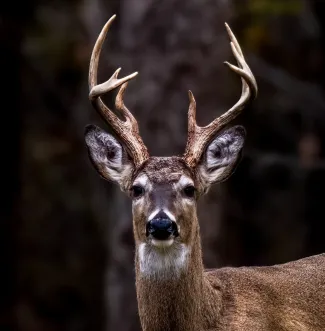I sat purposely still, but I felt awkwardly exposed. Not much I could do about it, either. My location- at the base of a small, lone tree - was my only alternative for bowhunting an active scrape I'd located the day before. I had no cover around me and I could be silhouetted from several different angles. In my favor, though, were the wind, sun, and a slight ridge that gave me a good vantage point for enjoying a spectacular fall morning.
An absolutely gorgeous sunrise unfolded before me. It was a bit cool, but nevertheless perfect for hunting. Clear and almost still, the day began with the hazy mystique of a light ground fog. The rays of the rising sun slowly searched for the openings they needed to filter down into the woodland scene. Autumn trees began to glow in all shades of red, yellow and orange. I sat totally entranced by the beauty of this pristine, natural world.
"How can it get any better," I thought, answering myself immediately with the image of a nice buck appearing at the nearby scrape. "Naw," I smiled, trying to convince myself of a new line of reasoning. "A deer would only break the serenity, cause an adrenaline surge, increase my heart rate - who needs it. This is just fine the way it is."

It was then that I heard a strange clicking noise from somewhere behind me. It didn't take long before my curiosity got the best of me and I slowly scrunched around for a look. At that moment, my hunt did get better. In a little valley below me was one of the most phenomenally beautiful sights I've ever seen. The scene was backlighted by the morning sun, which made the dew covered grasses twinkle and glisten. The colorful leaves were rimmed with bright light, like a fringe of sparkling diamonds. The ground fog glowed pale gold. A meandering creek shined with the brilliant reflection of the daybreak sky. And right in the middle of it all were two magnificent whitetail bucks, sparring gingerly, rapping the tips of their antlers together, making the odd clicking sound I'd heard.
Both deer had symmetrical racks: one an eight pointer, the other a 10. They'd lower their heads and push their antlers together. They turned their heads side to side, each tapping its long tines against the heavy main beams of the other. They pushed each other back and forth several times before parting and stepping back again to stare, stomp and snort. Then the whole process started over.
The ground fog sometimes obscured their legs, making their movements ghostlike and ethereal. When they snorted I could see their breath steam from their nostrils. The drama, beauty and uniqueness of the scene was awesome, almost hard to believe, like something from a movie. Sadly, it lasted only a few short minutes.
The bucks suddenly raised their heads and walked off in different directions. Both seemed to saunter as if proud and cocky, like they had really showed their opponent a thing or two. In a moment they were gone, disappearing into the oaks.
I sat transfixed, totally mesmerized, almost afraid to move or think for fear that I might erase the magic of the moment. I didn't want it to end, but I knew that I would never forget it. And suddenly, I honestly didn't care if a deer ever appeared at the scrape where I was hunting. I realized that the scene I'd just witnessed was an example of the real reason why I bowhunt.
That memorable morning was 17 years ago.
In spite of remarkable advancements, archers are still quite disadvantaged compared to other deer hunters. To be successful, they often must rely on a higher level of knowledge, woodsmanship and patience. The rewards, in turn, provide many with a deeper satisfaction.
I've managed to take a number of archery deer since that day, some of which provided me with more thrills and personal satisfactions than I could ever relate. But when I stop to reflect on my best bowhunting memories - all the amazing encounters and heartstopping action - I still think of those fighting bucks. I probably always will.
The outdoor world is a truly wondrous place. Archery season, even more so than Oklahoma's other deer seasons, is a chance to learn and experience much of what this world has to offer. To hunt with a bow is to invite limitations on yourself, to increase the chal1enge. By design, a bowhunter is forced to develop more refined skills, patience and understanding of himself and his quarry. Through their own capabilities and ingenuity, bowhunters often must work to find a way to succeed. By hunting within these constraints, archery deer hunters begin to understand a deeper appreciation of the outdoor world. This in turn translates to more meaningful personal enrichment at the end of a hunt.

Success in bowhunting can be a rather elusive connotation. It's not always measured in terms of game brought to bag. More often it's the thrill of seeing game, a close call, or just being there for the opportunity. For bowhunters who genuinely apply themselves, there are many sources for absorbing enough energy and inspiration to go again; to try again.
A few years ago my son, Tim, and I experienced a great hunt that would become another of my most fond memories and inspirations. All of my hunts with family, whether they're with my sons, dad or wife, seem to take on extra zest and vibrancy. But this particular hunt had all the classic elements as well.
We had spent all summer tuning and practicing with our gear. The entire month before season opened we shot broadheads only. We had even participated in an organized 30 shoot that closely simulated hunting conditions. By the time season opened, no target was too small. Our favorite trick was severing the stem of a daisy at 20 yards. We were definitely honed!
We had made several scouting trips to the hunt area, a fantastic piece of overgrown woodland in western Oklahoma, and we had a good idea of likely feeding and bedding areas and the heaviest-used trails that connected them. All of these were noted on a topographic map. There were several ridges cropping up from a bottomland that ran diagonally across the area, and along the creek was a veritable jungle of vegetation. We found tracks, trails, droppings, rubs and even a few small scrapes situated about, and we placed our stands in strategic, concealed places.
By Saturday morning of the third weekend of season, however, neither of us had seen a deer. Something was wrong. I wondered if the deer were using the bottom only at night, or maybe we just hadn't located the core area of activity yet. That afternoon, map in hand, we scouted the ridges.

We found a different kind of habitat. Scrub oaks and squatty blackjacks were laden with acorns but offered no chance for a treestand. At the top of the slope, though, were some larger trees with overhanging limbs- the kind of place where deer hunters would hope to find scrapes. And sure enough, shaded beneath the branches, were some huge ones up to four yards across. They were freshly pawed and wet. I could actually smell the odor of deer in the air. We relocated our stands, confident we had found a honey hole.
At 5:30 that evening, I heard a grunt. I slowly peered around and there he was, about 75 yards away, a big-bodied 10-pointer. Its head was down as if trailing, and it was slowly working my direction. My adrenaline rushed. My heart leaped into my throat and I had to remind myself to breath. Calm down! The buck came closer and closer, ever so slowly. I raised my bow and got ready.
The buck was in range now, maybe 35 yards. I pulled to full draw, but I was a mess. My mind was racing, my pulse was pounding and my knees were wobbling. My mouth was so dry I couldn't swallow. My brain was screaming for the rest of my body to cooperate. Somehow I managed to remember my bow sights and line up the orange, 30-yard bead with a spot just behind the buck's shoulder.
The deer raised its head and looked around. I almost released, but waited. I knew my odds would be better when it lowered its head again. Only my weeks and months of practice held me together for the next few moments. Without practice I'd have never had the strength to wait for a better shot. Finally the deer relaxed, dropped its head and prepared to take a step.
My arrow flew true. The buck went down within sight, about 60 yards away. My son appeared, excited, "Did you get him? I heard you shoot."
I'll never forget nodding and pointing down the hill. "Yes, he's right down there." That night in camp was really special. We couldn't stop talking about what a great day it had been. But just like other hunts I've experienced, this one also found a way to get even better. The next morning Tim got a deer, too, a nice little buck that was working down the same ridge.
Bowhunting has provided me with some of my life's finest memories, the kinds of things I ponder and reflect on when I'm perched in a treestand in some gorgeous autumn woodland. Each year when the leaves blush red, yellow and orange, I have no trouble finding the inspiration that takes me back to the deer woods. And regardless of whether or not an arrow ever leaves my string, I know I'll be a richer man for having done so.
This story was originally published in Outdoor Oklahoma Magazine in the Sept. - Oct., 1993 issue.